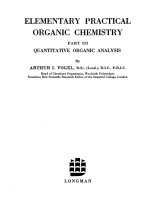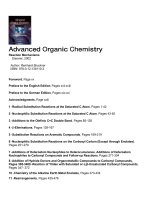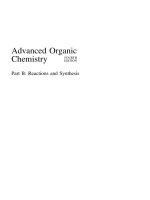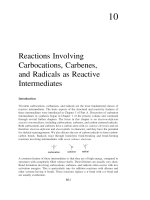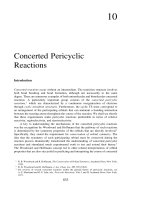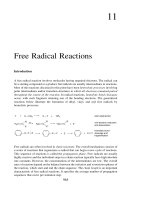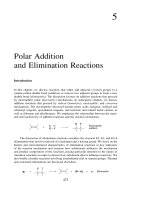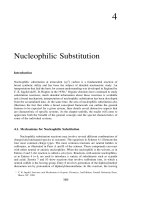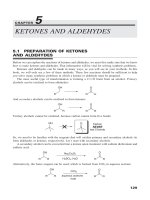Ebook Advanced organic chemistry (Part A Structure and mechanisms 5th edition) Part 1
Bạn đang xem bản rút gọn của tài liệu. Xem và tải ngay bản đầy đủ của tài liệu tại đây (15.56 MB, 596 trang )
Advanced Organic
Chemistry
FIFTH
EDITION
Part A: Structure and Mechanisms
Advanced Organic Chemistry
PART A: Structure and Mechanisms
PART B: Reactions and Synthesis
Advanced Organic
FIFTH
EDITION
Chemistry
Part A: Structure and Mechanisms
FRANCIS A. CAREY
and RICHARD J. SUNDBERG
University of Virginia
Charlottesville, Virginia
Francis A. Carey
Department of Chemistry
University of Virginia
Charlottesville, VA 22904
Richard J. Sundberg
Department of Chemistry
University of Virginia
Charlottesville, VA 22904
Library of Congress Control Number: 2006939782
ISBN-13: 978-0-387-44897-8 (hard cover)
ISBN-13: 978-0-387-68346-1 (soft cover)
e-ISBN-13: 978-0-387-44899-3
Printed on acid-free paper.
©2007 Springer Science+Business Media, LLC
All rights reserved. This work may not be translated or copied in whole or in part without the written
permission of the publisher (Springer Science+Business Media, LLC, 233 Spring Street, New York,
NY 10013, USA), except for brief excerpts in connection with reviews or scholarly analysis. Use in
connection with any form of information storage and retrieval, electronic adaptation, computer software, or
by similar or dissimilar methodology now know or hereafter developed is forbidden.
The use in this publication of trade names, trademarks, service marks and similar terms, even if they are
not identified as such, is not to be taken as an expression of opinion as to whether or not they are subject
to proprietary rights.
9 8 7 6 5 4 3 2 1
springer.com
Preface
This Fifth Edition marks the beginning of the fourth decade that Advanced Organic
Chemistry has been available. As with the previous editions, the goal of this text is to
allow students to build on the foundation of introductory organic chemistry and attain
a level of knowledge and understanding that will permit them to comprehend much
of the material that appears in the contemporary chemical literature. There have been
major developments in organic chemistry in recent years, and these have had a major
influence in shaping this new edition to make it more useful to students, instructors,
and other readers.
The expanding application of computational chemistry is reflected by amplified
discussion of this area, especially density function theory (DFT) calculations in
Chapter 1. Examples of computational studies are included in subsequent chapters
that deal with specific structures, reactions and properties. Chapter 2 discusses the
principles of both configuration and conformation, which were previously treated in
two separate chapters. The current emphasis on enantioselectivity, including development of many enantioselective catalysts, prompted the expansion of the section on
stereoselective reactions to include examples of enantioselective reactions. Chapter 3,
which covers the application of thermodynamics and kinetics to organic chemistry,
has been reorganized to place emphasis on structural effects on stability and reactivity.
This chapter lays the groundwork for later chapters by considering stability effects on
carbocations, carbanions, radicals, and carbonyl compounds.
Chapters 4 to 7 review the basic substitution, addition, and elimination mechanisms, as well as the fundamental chemistry of carbonyl compounds, including enols
and enolates. A section on of the control of regiochemistry and stereo- chemistry of
aldol reactions has been added to introduce the basic concepts of this important area. A
more complete treatment, with emphasis on synthetic applications, is given in Chapter
2 of Part B.
Chapter 8 deals with aromaticity and Chapter 9 with aromatic substitution, emphasizing electrophilic aromatic substitution. Chapter 10 deals with concerted pericyclic
reactions, with the aromaticity of transition structures as a major theme. This part of
the text should help students solidify their appreciation of aromatic stabilization as a
fundamental concept in the chemistry of conjugated systems. Chapter 10 also considers
v
vi
Preface
the important area of stereoselectivity of concerted pericyclic reactions. Instructors
may want to consider dealing with these three chapters directly after Chapter 3, and
we believe that is feasible.
Chapters 11 and 12 deal, respectively, with free radicals and with photochemistry
and, accordingly, with the chemistry of molecules with unpaired electrons. The latter
chapter has been substantially updated to reflect the new level of understanding that
has come from ultrafast spectroscopy and computational studies.
As in the previous editions, a significant amount of specific information is
provided in tables and schemes. These data and examples serve to illustrate the issues
that have been addressed in the text. Instructors who want to achieve a broad coverage,
but without the level of detail found in the tables and schemes, may choose to advise
students to focus on the main text. In most cases, the essential points are clear from
the information and examples given in the text itself.
We have made an effort to reduce the duplication between Parts A and B. In
general, the discussion of basic mechanisms in Part B has been reduced by crossreferencing the corresponding discussion in Part A. We have expanded the discussion
of specific reactions in Part A, especially in the area of enantioselectivity and enantioselective catalysts.
We have made more extensive use of abbreviations than in the earlier editions.
In particular, EWG and ERG are used throughout both Parts A and B to designate
electron-withdrawing and electron-releasing substituents, respectively. The intent is
that the use of these terms will help students generalize the effect of certain substituents
such as C=O, C≡N, NO2 , and RSO2 as electron withdrawing and R (alkyl) and RO
(alkoxy) as electron releasing. Correct use of this shorthand depends on a solid understanding of the interplay between polar and resonance effects in overall substituent
effects. This matter is discussed in detail in Chapter 3 and many common functional
groups are classified.
Several areas have been treated as “Topics”. Some of the Topics discuss areas that
are still in a formative stage, such as the efforts to develop DFT parameters as quantitative
reactivity indices. Others, such as the role of carbocations in gasoline production, have
practical implications.
We have also abstracted information from several published computational studies
to present three-dimensional images of reactants, intermediates, transition structures,
and products. This material, including exercises, is available at the publishers web site,
and students who want to see how the output of computations can be applied may want
to study it. The visual images may help toward an appreciation of some of the subtle
effects observed in enantioselective and other stereoselective reactions. As in previous
editions, each chapter has a number of problems drawn from the literature. A new
feature is solutions to these problems, which are also provided at the publisher’s
website at springer.com/carey-sundberg
Our goal is to present a broad and fairly detailed view of the core area of organic
reactivity. We have approached this goal by extensive use of both the primary and
review literature and the sources are referenced. Our hope is that the reader who
works through these chapters, problems, topics, and computational studies either in an
organized course or by self-study will be able to critically evaluate and use the current
literature in organic chemistry in the range of fields in which is applied, including
the pharmaceutical industry, agricultural chemicals, consumer products, petroleum
chemistry, and biotechnology. The companion volume, Part B, deals extensively with
organic synthesis and provides many more examples of specific reactions.
Acknowledgment
and Personal Statement
The revision and updating of Advanced Organic Chemistry that appears as the Fifth
Edition spanned the period September 2002 through December 2006. Each chapter
was reworked and updated and some reorganization was done, as described in the
Prefaces to Parts A and B. This period began at the point of conversion of library
resources to electronic form. Our university library terminated paper subscriptions to
the journals of the American Chemical Society and other journals that are available
electronically as of the end of 2002. Shortly thereafter, an excavation mishap at an
adjacent construction project led to structural damage and closure of our departmental
library. It remained closed through June 2007, but thanks to the efforts of Carol Hunter,
Beth Blanton-Kent, Christine Wiedman, Robert Burnett, and Wynne Stuart, I was able
to maintain access to a few key print journals including the Journal of the American
Chemical Society, Journal of Organic Chemistry, Organic Letters, Tetrahedron, and
Tetrahedron Letters. These circumstances largely completed an evolution in the source
for specific examples and data. In the earlier editions, these were primarily the result
of direct print encounter or search of printed Chemical Abstracts indices. The current
edition relies mainly on electronic keyword and structure searches. Neither the former
nor the latter method is entirely systematic or comprehensive, so there is a considerable
element of circumstance in the inclusion of specific material. There is no intent that
specific examples reflect either priority of discovery or relative importance. Rather,
they are interesting examples that illustrate the point in question.
Several reviewers provided many helpful corrections and suggestions, collated
by Kenneth Howell and the editorial staff of Springer. Several colleagues provided
valuable contributions. Carl Trindle offered suggestions and material from his course
on computational chemistry. Jim Marshall reviewed and provided helpful comments
on several sections. Michal Sabat, director of the Molecular Structure Laboratory,
provided a number of the graphic images. My co-author, Francis A. Carey, retired
in 2000 to devote his full attention to his text, Organic Chemistry, but continued to
provide valuable comments and insights during the preparation of this edition. Various
users of prior editions have provided error lists, and, hopefully, these corrections have
vii
viii
Acknowledgment
and Personal Statement
been made. Shirley Fuller and Cindy Knight provided assistance with many aspects
of the preparation of the manuscript.
This Fifth Edition is supplemented by the Digital Resource that is available at
springer.com/carey-sundberg. The Digital Resource summarizes the results of several
computational studies and presents three-dimensional images, comments, and exercises
based on the results. These were developed with financial support from the Teaching
Technology Initiative of the University of Virginia. Technical support was provided by
Michal Sabat, William Rourk, Jeffrey Hollier, and David Newman. Several students
made major contributions to this effort. Sara Fitzgerald Higgins and Victoria Landry
created the prototypes of many of the sites. Scott Geyer developed the dynamic
representations using IRC computations. Tanmaya Patel created several sites and
developed the measurement tool. I also gratefully acknowledge the cooperation of the
original authors of these studies in making their output available. Problem Responses
have been provided and I want to acknowledge the assistance of R. Bruce Martin,
David Metcalf, and Daniel McCauley in helping work out some of the specific kinetic
problems and in providing the attendant graphs.
It is my hope that the text, problems, and other material will assist new students
to develop a knowledge and appreciation of structure, mechanism, reactions, and
synthesis in organic chemistry. It is gratifying to know that some 200,000 students
have used earlier editions, hopefully to their benefit.
Richard J. Sundberg
Charlottesville, Virginia
March 2007
Introduction
This volume is intended for students who have completed the equivalent of a
two-semester introductory course in organic chemistry and wish to expand their understanding of structure and reaction mechanisms in organic chemistry. The text assumes
basic knowledge of physical and inorganic chemistry at the advanced undergraduate
level.
Chapter 1 begins by reviewing the familiar Lewis approach to structure and
bonding. Lewis’s concept of electron pair bonds, as extended by adding the ideas of
hybridization and resonance, plus fundamental atomic properties such as electronegativity and polarizability provide a solid foundation for qualitative descriptions of
trends in reactivity. In polar reactions, for example, the molecular properties of acidity,
basicity, nucleophilicity, and electrophilicity can all be related to information embodied
in Lewis structures. The chapter continues with the more quantitative descriptions of
molecular structure and properties that are obtained by quantum mechanical calculations. Hückel, semiempirical, and ab initio molecular orbital (MO) calculations, as well
as density functional theory (DFT) are described and illustrated with examples. This
material is presented at a level sufficient for students to recognize the various methods
and their ranges of application. Computational methods can often provide insight
into reaction mechanisms by describing the structural features of intermediates and
transition structures. Another powerful aspect of computational methods is their ability
to represent electron density. Various methods of describing electron density, including
graphical representations, are outlined in this chapter and applied throughout the
remainder of the text. Chapter 2 explores the two structural levels of stereochemistry—
configuration and conformation. Molecular conformation is important in its own right,
but can also influence reactivity. The structural relationships between stereoisomers and
the origin and consequences of molecular chirality are discussed. After reviewing the
classical approach to resolving racemic mixtures, modern methods for chromatographic
separation and kinetic resolution are described. The chapter also explores how stereochemistry affects reactivity with examples of diastereoselective and enantioselective
reactions, especially those involving addition to carbonyl groups. Much of today’s work
in organic chemistry focuses on enantioselective reagents and catalysts. The enantioselectivity of these reagents usually involves rather small and sometimes subtle differences in intermolecular interactions. Several of the best-understood enantioselective
ix
x
Introduction
reactions, including hydrogenation, epoxidation of allylic alcohols, and dihydroxylation
of alkenes are discussed. Chapter 3 provides examples of structure-stability relationships derived from both experimental thermodynamics and computation. Most of the
chapter is about the effects of substituents on reaction rates and equilibria, how they are
measured, and what they tell us about reaction mechanisms. The electronic character of
the common functional groups is explored, as well as substituent effects on the stability
of carbocations, carbanions, radicals, and carbonyl addition intermediates. Other topics
in this chapter include the Hammett equation and related linear free-energy relationships, catalysis, and solvent effects. Understanding how thermodynamic and kinetic
factors combine to influence reactivity and developing a sense of structural effects on
the energy of reactants, intermediates and transition structures render the outcome of
organic reactions more predictable.
Chapters 4 to 7 relate the patterns of addition, elimination, and substitution
reactions to the general principles developed in Chapters 1 to 3. A relatively small
number of reaction types account for a wide range of both simple and complex
reactions. The fundamental properties of carbocations, carbanions, and carbonyl
compounds determine the outcome of these reactions. Considerable information about
reactivity trends and stereoselectivity is presented, some of it in tables and schemes.
Although this material may seem overwhelming if viewed as individual pieces of information, taken in the context of the general principles it fills in details and provides a
basis for recognizing the relative magnitude of various structural changes on reactivity.
The student should strive to develop a sufficiently broad perspective to generate an
intuitive sense of the effect of particular changes in structure.
Chapter 4 begins the discussion of specific reaction types with an examination of
nucleophilic substitution. Key structural, kinetic, and stereochemical features of substitution reactions are described and related to reaction mechanisms. The limiting mechanisms SN 1 and SN 2 are presented, as are the “merged” and “borderline” variants. The
relationship between stereochemistry and mechanism is explored and specific examples
are given. Inversion is a virtually universal characteristic of the SN 2 mechanism,
whereas stereochemistry becomes much more dependent on the specific circumstances
for borderline and SN 1 mechanisms. The properties of carbocations, their role in
nucleophilic substitution, carbocation rearrangements, and the existence and relative
stability of bridged (nonclassical) carbocations are considered. The importance of
carbocations in many substitution reactions requires knowledge of their structure and
reactivity and the effect of substituents on stability. A fundamental characteristic of
carbocations is the tendency to rearrange to more stable structures. We consider the
mechanism of carbocation rearrangements, including the role of bridged ions. The case
of nonclassical carbocations, in which the bridged structure is the most stable form, is
also discussed.
Chapter 5 considers the relationship between mechanism and regio- and stereoselectivity. The reactivity patterns of electrophiles such as protic acids, halogens,
sulfur and selenium electrophiles, mercuric ion, and borane and its derivatives are
explored and compared. These reactions differ in the extent to which they proceed
through discrete carbocations or bridged intermediates and this distinction can explain
variations in regio- and stereochemistry. This chapter also describes the E1, E2, and
E1cb mechanisms for elimination and the idea that these represent specific cases
within a continuum of mechanisms. The concept of the variable mechanism can
explain trends in reactivity and regiochemistry in elimination reactions. Chapter 6
focuses on the fundamental properties and reactivity of carbon nucleophiles, including
organometallic reagents, enolates, enols, and enamines. The mechanism of the aldol
addition is discussed. The acidity of hydrocarbons and functionalized molecules is
considered. Chapter 7 discusses the fundamental reactions of carbonyl groups. The
reactions considered include hydration, acetal formation, condensation with nitrogen
nucleophiles, and the range of substitution reactions that interconvert carboxylic acid
derivatives. The relative stability and reactivity of the carboxylic acid derivatives is
summarized and illustrated. The relationships described in Chapters 6 and 7 provide the
broad reactivity pattern of carbonyl compounds, which has been extensively developed
and is the basis of a rich synthetic methodology.
Chapter 8 discusses the concept of aromaticity and explores the range of its applicability, including annulenes, cyclic cations and anions, polycyclic hydrocarbons, and
heterocyclic aromatic compounds. The criteria of aromaticity and some of the methods
for its evaluation are illustrated. We also consider the antiaromaticity of cyclobutadiene
and related molecules. Chapter 9 explores the mechanisms of aromatic substitution
with an emphasis on electrophilic aromatic substitution. The general mechanism is
reviewed and the details of some of the more common reactions such as nitration,
halogenation, Friedel-Crafts alkylation, and acylation are explored. Patterns of position
and reactant selectivity are examined. Recent experimental and computational studies
that elucidate the role of aromatic radical cations generated by electron transfer in
electrophilic aromatic substitution are included, and the mechanisms for nucleophilic
aromatic substitution are summarized. Chapter 10 deals with concerted pericyclic
reactions, including cycloaddition, electrocyclic reactions, and sigmatropic rearrangements. This chapter looks at how orbital symmetry influences reactivity and introduces
the idea of aromaticity in transition structures. These reactions provide interesting
examples of how stereochemistry and reactivity are determined by the structure of the
transition state. The role of Lewis acids in accelerating Diels-Alder reactions and the
use of chiral auxiliaries and catalysts to achieve enantioselectivity are explored.
Chapter 11 deals with free radicals and their reactions. Fundamental structural
concepts such as substituent effects on bond dissociation enthalpies (BDE) and radical
stability are key to understanding the mechanisms of radical reactions. The patterns of
stability and reactivity are illustrated by discussion of some of the absolute rate data
that are available for free radical reactions. The reaction types that are discussed include
halogenation and oxygenation, as well as addition reactions of hydrogen halides, carbon
radicals, and thiols. Group transfer reactions, rearrangements, and fragmentations are
also discussed.
Chapter 12 ventures into the realm of photochemistry, where structural concepts
are applied to following the path from initial excitation to the final reaction product.
Although this discussion involves comparison with some familiar intermediates,
especially radicals, and offers mechanisms to account for the reactions, photochemistry
introduces some new concepts of reaction dynamics. The excited states in photochemical reactions traverse energy surfaces that have small barriers relative to most
thermal reactions. Because several excited states can be involved, the mechanism
of conversion between excited states is an important topic. The nature of conical
intersections, the transition points between excited state energy surfaces is examined.
Fundamental concepts of structure and its relationship to reactivity within the
context of organic chemistry are introduced in the first three chapters, and thereafter
the student should try to relate the structure and reactivity of the intermediates and
transition structures to these concepts. Critical consideration of bonding, stereochemistry, and substituent effects should come into play in examining each of the basic
xi
Introduction
xii
Introduction
reactions. Computational studies frequently serve to focus on particular aspects of
the reaction mechanism. Many specific reactions are cited, both in the text and in
schemes and tables. The purpose of this specific information is to illustrate the broad
patterns of reactivity. As students study this material, the goal should be to look for the
underlying relationships in the broad reactivity patterns. Organic reactions occur by
a combination of a relatively few reaction types—substitution, addition, elimination,
and rearrangement. Reagents can generally be classified as electrophilic, nucleophilic,
or radical in character. By focusing on the fundamental character of reactants and
reagents, students can develop a familiarity with organic reactivity and organize the
vast amount of specific information on reactions.
Contents
Preface . . . . . . . . . . . . . . . . . . . . . . . . . . . . . . . . . . . . . . . . . . . . . . . . . . . . . . . . . . . . . . . . . .
v
Acknowledgment and Personal Statement . . . . . . . . . . . . . . . . . . . . . . . . . . . . . . . .
vii
Introduction . . . . . . . . . . . . . . . . . . . . . . . . . . . . . . . . . . . . . . . . . . . . . . . . . . . . . . . . . . . .
ix
Chapter 1.
Chemical Bonding and Molecular Structure . . . . . . . . . . . . . . . . .
1
Introduction ............................................................................................................
1.1. Description of Molecular Structure Using Valence Bond Concepts ............
1.1.1. Hybridization ......................................................................................
1.1.2. The Origin of Electron-Electron Repulsion .......................................
1.1.3. Electronegativity and Polarity ............................................................
1.1.4. Electronegativity Equalization............................................................
1.1.5. Differential Electronegativity of Carbon Atoms................................
1.1.6. Polarizability, Hardness, and Softness ...............................................
1.1.7. Resonance and Conjugation ...............................................................
1.1.8. Hyperconjugation................................................................................
1.1.9. Covalent and van der Waals Radii of Atoms ....................................
1.2. Molecular Orbital Theory and Methods........................................................
1.2.1. The Hückel MO Method ....................................................................
1.2.2. Semiempirical MO Methods ..............................................................
1.2.3. Ab Initio Methods...............................................................................
1.2.4. Pictorial Representation of MOs for Molecules ................................
1.2.5. Qualitative Application of MO Theory to Reactivity:
Perturbational MO Theory and Frontier Orbitals ..............................
1.2.6. Numerical Application of MO Theory...............................................
1.3. Electron Density Functionals.........................................................................
1.4. Representation of Electron Density Distribution ..........................................
1.4.1. Mulliken Population Analysis ............................................................
1.4.2. Natural Bond Orbitals and Natural Population Analysis...................
1
2
4
7
8
11
12
14
18
22
24
26
27
32
32
35
xiii
41
50
54
57
60
61
xiv
Contents
1.4.3. Atoms in Molecules ............................................................................
1.4.4. Comparison and Interpretation of Atomic Charge
Calculations .........................................................................................
1.4.5. Electrostatic Potential Surfaces...........................................................
1.4.6. Relationships between Electron Density and Bond Order .................
Topic 1.1. The Origin of the Rotational (Torsional) Barrier in Ethane
and Other Small Molecules.................................................................
Topic 1.2. Heteroatom Hyperconjugation (Anomeric Effect)
in Acyclic Molecules...........................................................................
Topic 1.3. Bonding in Cyclopropane and Other Small Ring
Compounds ..........................................................................................
Topic 1.4. Representation of Electron Density by the Laplacian Function ........
Topic 1.5. Application of Density Functional Theory
to Chemical Properties and Reactivity ...............................................
T.1.5.1. DFT Formulation of Chemical Potential,
Electronegativity, Hardness and Softness,
and Covalent and van der Waal Radii .................................
T.1.5.2. DFT Formulation of Reactivity—The Fukui Function .......
T.1.5.3. DFT Concepts of Substituent Groups Effects .....................
General References.................................................................................................
Problems .................................................................................................................
63
95
97
100
106
106
Chapter 2.
Stereochemistry, Conformation, and Stereoselectivity . . . . . . . .
119
Introduction ............................................................................................................
2.1. Configuration..................................................................................................
2.1.1. Configuration at Double Bonds..........................................................
2.1.2. Configuration of Cyclic Compounds .................................................
2.1.3. Configuration at Tetrahedral Atoms...................................................
2.1.4. Molecules with Multiple Stereogenic Centers ...................................
2.1.5. Other Types of Stereogenic Centers ..................................................
2.1.6. The Relationship between Chirality and Symmetry ..........................
2.1.7. Configuration at Prochiral Centers.....................................................
2.1.8. Resolution—The Separation of Enantiomers.....................................
2.2. Conformation..................................................................................................
2.2.1. Conformation of Acyclic Compounds ...............................................
2.2.2. Conformations of Cyclohexane Derivatives ......................................
2.2.3. Conformations of Carbocyclic Rings of Other Sizes ........................
2.3. Molecular Mechanics .....................................................................................
2.4. Stereoselective and Stereospecific Reactions ................................................
2.4.1. Examples of Stereoselective Reactions..............................................
2.4.2. Examples of Stereospecific Reactions ...............................................
2.5. Enantioselective Reactions.............................................................................
2.5.1. Enantioselective Hydrogenation .........................................................
2.5.2. Enantioselective Reduction of Ketones..............................................
2.5.3. Enantioselective Epoxidation of Allylic Alcohols.............................
2.5.4. Enantioselective Dihydroxylation of Alkenes....................................
2.6. Double Stereodifferentiation: Reinforcing
and Competing Stereoselectivity ...................................................................
119
119
119
121
122
126
128
131
133
136
142
142
152
161
167
169
170
182
189
189
193
196
200
70
73
76
78
81
85
92
94
204
Topic 2.1. Analysis and Separation of Enantiomeric Mixtures...........................
T.2.1.1. Chiral Shift Reagents and Chiral
Solvating Agents...................................................................
T.2.1.2. Separation of Enantiomers ...................................................
Topic 2.2. Enzymatic Resolution and Desymmetrization....................................
T.2.2.1. Lipases and Esterases...........................................................
T.2.2.2. Proteases and Acylases ........................................................
T.2.2.3. Epoxide Hydrolases..............................................................
Topic 2.3. The Anomeric Effect in Cyclic Compounds ......................................
Topic 2.4. Polar Substituent Effects in Reduction
of Carbonyl Compounds .....................................................................
General References.................................................................................................
Problems .................................................................................................................
Chapter 3.
208
208
211
215
216
222
224
227
234
239
240
Structural Effects on Stability and Reactivity . . . . . . . . . . . . . . . .
253
Introduction.............................................................................................................
3.1. Thermodynamic Stability...............................................................................
3.1.1. Relationship between Structure and Thermodynamic
Stability for Hydrocarbons .................................................................
3.1.2. Calculation of Enthalpy of Formation and
Enthalpy of Reaction ..........................................................................
3.2. Chemical Kinetics ..........................................................................................
3.2.1. Fundamental Principles of Chemical Kinetics...................................
3.2.2. Representation of Potential Energy
Changes in Reactions..........................................................................
3.2.3. Reaction Rate Expressions .................................................................
3.2.4. Examples of Rate Expressions ...........................................................
3.3. General Relationships between Thermodynamic Stability
and Reaction Rates.........................................................................................
3.3.1. Kinetic versus Thermodynamic Control
of Product Composition......................................................................
3.3.2. Correlations between Thermodynamic and Kinetic Aspects
of Reactions ........................................................................................
3.3.3. Curtin-Hammett Principle...................................................................
3.4. Electronic Substituent Effects on Reaction Intermediates ............................
3.4.1. Carbocations........................................................................................
3.4.2. Carbanions ..........................................................................................
3.4.3. Radical Intermediates .........................................................................
3.4.4. Carbonyl Addition Intermediates .......................................................
3.5. Kinetic Isotope Effects...................................................................................
3.6. Linear Free-Energy Relationships for Substituent Effects............................
3.6.1. Numerical Expression of Linear Free-Energy
Relationships .......................................................................................
3.6.2. Application of Linear Free-Energy Relationships
to Characterization of Reaction Mechanisms ....................................
3.7. Catalysis .........................................................................................................
3.7.1. Catalysis by Acids and Bases.............................................................
3.7.2. Lewis Acid Catalysis ..........................................................................
253
254
256
257
270
270
273
280
283
285
285
287
296
297
300
307
311
319
332
335
335
342
345
345
354
xv
Contents
xvi
Contents
3.8. Solvent Effects ...............................................................................................
3.8.1. Bulk Solvent Effects...........................................................................
3.8.2. Examples of Specific Solvent Effects ................................................
Topic 3.1. Acidity of Hydrocarbons.....................................................................
General References.................................................................................................
Problems .................................................................................................................
359
359
362
368
376
376
Chapter 4.
Nucleophilic Substitution . . . . . . . . . . . . . . . . . . . . . . . . . . . . . . . . . . .
389
Introduction ............................................................................................................
4.1. Mechanisms for Nucleophilic Substitution ...................................................
4.1.1. Substitution by the Ionization SN 1 Mechanism..............................
4.1.2. Substitution by the Direct Displacement
SN 2 Mechanism ...............................................................................
4.1.3. Detailed Mechanistic Description
and Borderline Mechanisms ...............................................................
4.1.4. Relationship between Stereochemistry and Mechanism
of Substitution.....................................................................................
4.1.5. Substitution Reactions of Alkyldiazonium Ions ................................
4.2. Structural and Solvation Effects on Reactivity .............................................
4.2.1. Characteristics of Nucleophilicity ......................................................
4.2.2. Effect of Solvation on Nucleophilicity ..............................................
4.2.3. Leaving-Group Effects .......................................................................
4.2.4. Steric and Strain Effects on Substitution
and Ionization Rates ...........................................................................
4.2.5. Effects of Conjugation on Reactivity.................................................
4.3. Neighboring-Group Participation ..................................................................
4.4. Structure and Reactions of Carbocation Intermediates.................................
4.4.1. Structure and Stability of Carbocations .............................................
4.4.2. Direct Observation of Carbocations...................................................
4.4.3. Competing Reactions of Carbocations...............................................
4.4.4. Mechanisms of Rearrangement of Carbocations ...............................
4.4.5. Bridged (Nonclassical) Carbocations .................................................
Topic 4.1. The Role Carbocations and Carbonium Ions in Petroleum
Processing ............................................................................................
General References.................................................................................................
Problems .................................................................................................................
389
389
391
Chapter 5.
Polar Addition and Elimination Reactions . . . . . . . . . . . . . . . . . . .
473
Introduction.............................................................................................................
5.1. Addition of Hydrogen Halides to Alkenes..................................................
5.2. Acid-Catalyzed Hydration and Related Addition Reactions ......................
5.3. Addition of Halogens...................................................................................
5.4. Sulfenylation and Selenenylation ................................................................
5.4.1. Sulfenylation .....................................................................................
5.4.2. Selenenylation...................................................................................
5.5. Addition Reactions Involving Epoxides......................................................
5.5.1. Epoxides from Alkenes and Peroxidic Reagents.............................
5.5.2. Subsequent Transformations of Epoxides........................................
475
476
482
485
497
498
500
503
503
511
393
395
402
405
407
407
411
413
415
417
419
425
425
436
438
440
447
454
459
459
5.6. Electrophilic Additions Involving Metal Ions.............................................
5.6.1. Solvomercuration..............................................................................
5.6.2. Argentation—the Formation of Silver Complexes ..........................
5.7. Synthesis and Reactions of Alkylboranes ...................................................
5.7.1. Hydroboration ...................................................................................
5.7.2. Reactions of Organoboranes ............................................................
5.7.3. Enantioselective Hydroboration .......................................................
5.8. Comparison of Electrophilic Addition Reactions .......................................
5.9. Additions to Alkynes and Allenes...............................................................
5.9.1. Hydrohalogenation and Hydration of Alkynes ................................
5.9.2. Halogenation of Alkynes..................................................................
5.9.3. Mercuration of Alkynes....................................................................
5.9.4. Overview of Alkyne Additions ........................................................
5.9.5. Additions to Allenes .........................................................................
5.10. Elimination Reactions ..................................................................................
5.10.1. The E2, E1 and E1cb Mechanisms ................................................
5.10.2. Regiochemistry of Elimination Reactions .....................................
5.10.3. Stereochemistry of E2 Elimination Reactions ...............................
5.10.4. Dehydration of Alcohols ................................................................
5.10.5. Eliminations Reactions Not Involving C−H Bonds......................
General References ................................................................................................
Problems.................................................................................................................
515
515
520
521
522
526
529
531
536
538
540
544
544
545
546
548
554
558
563
564
569
569
Chapter 6.
Carbanions and Other Carbon Nucleophiles . . . . . . . . . . . . . . . . .
579
Introduction ............................................................................................................
6.1. Acidity of Hydrocarbons ...............................................................................
6.2. Carbanion Character of Organometallic Compounds ...................................
6.3. Carbanions Stabilized by Functional Groups................................................
6.4. Enols and Enamines.......................................................................................
6.5. Carbanions as Nucleophiles in SN 2 Reactions ..............................................
6.5.1. Substitution Reactions of Organometallic Reagents..........................
6.5.2. Substitution Reactions of Enolates.....................................................
General References.................................................................................................
Problems .................................................................................................................
559
579
588
591
601
609
609
611
619
619
Chapter 7.
Addition, Condensation and Substitution Reactions
of Carbonyl Compounds . . . . . . . . . . . . . . . . . . . . . . . . . . . . . . . . . . . .
Introduction.............................................................................................................
7.1. Reactivity of Carbonyl Compounds toward Addition ..................................
7.2. Hydration and Addition of Alcohols to Aldehydes and Ketones.................
7.3. Condensation Reactions of Aldehydes and Ketones with Nitrogen
Nucleophiles...................................................................................................
7.4. Substitution Reactions of Carboxylic Acid Derivatives ...............................
7.4.1. Ester Hydrolysis and Exchange .........................................................
7.4.2. Aminolysis of Esters ..........................................................................
7.4.3. Amide Hydrolysis...............................................................................
7.4.4. Acylation of Nucleophilic Oxygen and Nitrogen Groups.................
629
629
632
638
645
654
654
659
662
664
xvii
Contents
xviii
Contents
7.5. Intramolecular Catalysis of Carbonyl Substitution Reactions ......................
7.6. Addition of Organometallic Reagents to Carbonyl Groups..........................
7.6.1. Kinetics of Organometallic Addition Reactions ................................
7.6.2. Stereoselectivity of Organometallic Addition Reactions...................
7.7. Addition of Enolates and Enols to Carbonyl Compounds: The Aldol
Addition and Condensation Reactions ..........................................................
7.7.1. The General Mechanisms ...................................................................
7.7.2. Mixed Aldol Condensations with Aromatic Aldehydes....................
7.7.3. Control of Regiochemistry and Stereochemistry of Aldol
Reactions of Ketones..........................................................................
7.7.4. Aldol Reactions of Other Carbonyl Compounds...............................
General References.................................................................................................
Problems .................................................................................................................
668
676
677
680
Chapter 8.
Aromaticity . . . . . . . . . . . . . . . . . . . . . . . . . . . . . . . . . . . . . . . . . . . . . . . .
713
Introduction ............................................................................................................
8.1. Criteria of Aromaticity...................................................................................
8.1.1. The Energy Criterion for Aromaticity................................................
8.1.2. Structural Criteria for Aromaticity .....................................................
8.1.3. Electronic Criteria for Aromaticity ....................................................
8.1.4. Relationship among the Energetic, Structural, and Electronic
Criteria of Aromaticity .......................................................................
8.2. The Annulenes ...............................................................................................
8.2.1. Cyclobutadiene....................................................................................
8.2.2. Benzene ...............................................................................................
8.2.3. 1,3,5,7-Cyclooctatetraene ...................................................................
8.2.4. [10]Annulenes—1,3,5,7,9-Cyclodecapentaene Isomers.....................
8.2.5. [12], [14], and [16]Annulenes ............................................................
8.2.6. [18]Annulene and Larger Annulenes .................................................
8.2.7. Other Related Structures.....................................................................
8.3. Aromaticity in Charged Rings.......................................................................
8.4. Homoaromaticity............................................................................................
8.5. Fused-Ring Systems.......................................................................................
8.6. Heteroaromatic Systems ................................................................................
General References ................................................................................................
Problems .................................................................................................................
713
715
715
718
720
724
725
725
727
727
728
730
733
735
738
743
745
758
760
760
Chapter 9.
Aromatic Substitution . . . . . . . . . . . . . . . . . . . . . . . . . . . . . . . . . . . . . .
771
Introduction ............................................................................................................
9.1. Electrophilic Aromatic Substitution Reactions .............................................
9.2. Structure-Reactivity Relationships for Substituted Benzenes.......................
9.2.1. Substituent Effects on Reactivity .......................................................
9.2.2. Mechanistic Interpretation of the Relationship between
Reactivity and Selectivity...................................................................
9.3. Reactivity of Polycyclic and Heteroaromatic Compounds ...........................
771
771
779
779
682
682
685
687
692
698
698
787
791
9.4. Specific Electrophilic Substitution Reactions .............................................
9.4.1. Nitration............................................................................................
9.4.2. Halogenation.....................................................................................
9.4.3. Protonation and Hydrogen Exchange ..............................................
9.4.4. Friedel-Crafts Alkylation and Related Reactions............................
9.4.5. Friedel-Crafts Acylation and Related Reactions .............................
9.4.6. Aromatic Substitution by Diazonium Ions ......................................
9.4.7. Substitution of Groups Other than Hydrogen .................................
9.5. Nucleophilic Aromatic Substitution.............................................................
9.5.1. Nucleophilic Aromatic Substitution by the
Addition-Elimination Mechanism....................................................
9.5.2. Nucleophilic Aromatic Substitution by the
Elimination-Addition Mechanism....................................................
General References ................................................................................................
Problems.................................................................................................................
796
796
800
804
805
809
813
814
816
Chapter 10. Concerted Pericyclic Reactions . . . . . . . . . . . . . . . . . . . . . . . . . . . . . .
833
Introduction ............................................................................................................
10.1. Cycloaddition Reactions ..............................................................................
10.2. The Diels-Alder Reaction ............................................................................
10.2.1. Stereochemistry of the Diels-Alder Reaction.................................
10.2.2. Substituent Effects on Reactivity, Regioselectivity
and Stereochemistry........................................................................
10.2.3. Catalysis of Diels-Alder Reactions by Lewis Acids......................
10.2.4. Computational Characterization of Diels-Alder Transition
Structures.........................................................................................
10.2.5. Scope and Synthetic Applications of the
Diels-Alder Reaction.......................................................................
10.2.6. Enantioselective Diels-Alder Reactions .........................................
10.2.7. Intramolecular Diels-Alder Reactions ............................................
10.3. 1,3-Dipolar Cycloaddition Reactions...........................................................
10.3.1. Relative Reactivity, Regioselectivity, Stereoselectivity,
and Transition Structures ................................................................
10.3.2. Scope and Applications of 1,3-Dipolar Cycloadditions.................
10.3.3. Catalysis of 1,3-Dipolar Cycloaddition Reactions .........................
10.4. 2 + 2 Cycloaddition Reactions ..................................................................
10.5. Electrocyclic Reactions ................................................................................
10.5.1. Overview of Electrocyclic Reactions .............................................
10.5.2. Orbital Symmetry Basis for the Stereospecificity of
Electrocyclic Reactions...................................................................
10.5.3. Examples of Electrocyclic Reactions .............................................
10.5.4. Electrocyclic Reactions of Charged Species ..................................
10.5.5. Electrocyclization of Heteroatomic Trienes ...................................
10.6. Sigmatropic Rearrangements .......................................................................
10.6.1. Overview of Sigmatropic Rearrangements.....................................
10.6.2. [1,3]-, [1,5]-, and [1,7]-Sigmatropic Shifts of Hydrogen
and Alkyl Groups............................................................................
833
834
839
839
817
821
824
824
843
848
851
860
865
868
873
874
884
886
888
892
892
894
903
906
910
911
911
912
xix
Contents
xx
Contents
10.6.3. Overview of [3,3]-Sigmatropic Rearrangements .................
10.6.4. [2,3]-Sigmatropic Rearrangements.......................................
Topic 10.1. Application of DFT Concepts to Reactivity and Regiochemistry
of Cycloaddition Reactions ...............................................................
Problems .................................................................................................................
919
939
Chapter 11. Free Radical Reactions . . . . . . . . . . . . . . . . . . . . . . . . . . . . . . . . . . . . .
965
Introduction ............................................................................................................
11.1. Generation and Characterization of Free Radicals......................................
11.1.1. Background .....................................................................................
11.1.2. Long-Lived Free Radicals ..............................................................
11.1.3. Direct Detection of Radical Intermediates .....................................
11.1.4. Generation of Free Radicals ...........................................................
11.1.5. Structural and Stereochemical Properties of Free Radicals...........
11.1.6. Substituent Effects on Radical Stability.........................................
11.1.7. Charged Radicals ............................................................................
11.2. Characteristics of Reactions Involving Radical Intermediates ...................
11.2.1. Kinetic Characteristics of Chain Reactions....................................
11.2.2. Determination of Reaction Rates....................................................
11.2.3. Structure-Reactivity Relationships .................................................
11.3. Free Radical Substitution Reactions ............................................................
11.3.1. Halogenation ...................................................................................
11.3.2. Oxygenation ....................................................................................
11.4. Free Radical Addition Reactions .................................................................
11.4.1. Addition of Hydrogen Halides .......................................................
11.4.2. Addition of Halomethanes ..............................................................
11.4.3. Addition of Other Carbon Radicals................................................
11.4.4. Addition of Thiols and Thiocarboxylic Acids ...............................
11.4.5. Examples of Radical Addition Reactions.......................................
11.5. Other Types of Free Radical Reactions.......................................................
11.5.1. Halogen, Sulfur, and Selenium Group Transfer Reactions ...........
11.5.2. Intramolecular Hydrogen Atom Transfer Reactions ......................
11.5.3. Rearrangement Reactions of Free Radicals....................................
11.6. SRN 1 Substitution Processes.........................................................................
11.6.1. SRN 1 Substitution Reactions of Alkyl Nitro Compounds..............
11.6.2. SRN 1 Substitution Reactions of Aryl and Alkyl Halides ...............
Topic 11.1. Relationships between Bond and Radical
Stabilization Energies........................................................................
Topic 11.2. Structure-Reactivity Relationships in Hydrogen Abstraction
Reactions............................................................................................
General References.................................................................................................
Problems .................................................................................................................
965
967
967
968
970
976
980
986
988
992
992
995
1000
1018
1018
1024
1026
1026
1029
1031
1033
1033
1037
1037
1040
1041
1044
1045
1048
945
951
1052
1056
1062
1063
Chapter 12. Photochemistry . . . . . . . . . . . . . . . . . . . . . . . . . . . . . . . . . . . . . . . . . . . . . 1073
Introduction............................................................................................................. 1073
12.1. General Principles ........................................................................................ 1073
12.2. Photochemistry of Alkenes, Dienes, and Polyenes .....................................
12.2.1. cis-trans Isomerization ...................................................................
12.2.2. Photoreactions of Other Alkenes ...................................................
12.2.3. Photoisomerization of 1,3-Butadiene .............................................
12.2.4. Orbital Symmetry Considerations for Photochemical
Reactions of Alkenes and Dienes ..................................................
12.2.5. Photochemical Electrocyclic Reactions .........................................
12.2.6. Photochemical Cycloaddition Reactions........................................
12.2.7. Photochemical Rearrangements Reactions of 1,4-Dienes .............
12.3. Photochemistry of Carbonyl Compounds....................................................
12.3.1. Hydrogen Abstraction and Fragmentation Reactions ....................
12.3.2. Cycloaddition and Rearrangement Reactions of Cyclic
Unsaturated Ketones.......................................................................
12.3.3. Cycloaddition of Carbonyl Compounds and Alkenes ...................
12.4. Photochemistry of Aromatic Compounds ...................................................
Topic 12.1. Computational Interpretation of Diene
and Polyene Photochemistry .............................................................
General References.................................................................................................
Problems .................................................................................................................
1081
1081
1091
1096
1097
1100
1109
1112
1116
1118
1125
1132
1134
1137
1145
1146
References to Problems . . . . . . . . . . . . . . . . . . . . . . . . . . . . . . . . . . . . . . . . . . . . . . . . . . 1155
Index . . . . . . . . . . . . . . . . . . . . . . . . . . . . . . . . . . . . . . . . . . . . . . . . . . . . . . . . . . . . . . . . . . . 1171
xxi
Contents
1
Chemical Bonding
and Molecular Structure
Introduction
In this chapter we consider molecular structure and the concepts of chemical bonding
that are used to interpret molecular structure. We will also begin to see how information about molecular structure and ideas about bonds can be used to interpret and
predict physical properties and chemical reactivity. Structural formulas are a key tool
for describing both structure and reactivity. At a minimum, they indicate molecular
constitution by specifying the connectivity among the atoms in the molecule. Structural formulas also give a rough indication of electron distribution by representing
electron pairs in bonds by lines and unshared electrons as dots, although the latter are
usually omitted in printed structures. The reader is undoubtedly familiar with structural
formulas for molecules such as those shown in Scheme 1.1.
In quantitative terms, molecular structure specifies the relative position of all
atoms in a molecule. These data provide the bond lengths and bond angles. There
are a number of experimental means for precise determination of molecular structure,
primarily based on spectroscopic and diffraction methods, and structural data are
available for thousands of molecules. Structural information and interpretation is also
provided by computational chemistry. In later sections of this chapter, we describe how
molecular orbital theory and density functional theory can be applied to the calculation
of molecular structure and properties.
The distribution of electrons is another element of molecular structure that is
very important for understanding chemical reactivity. It is considerably more difficult
to obtain experimental data on electron density, but fortunately, in recent years the
rapid development of both structural theory and computational methods has allowed
such calculations. We make use of computational electron density data in describing
molecular structure, properties, and reactivity. In this chapter, we focus on the minimum
energy structure of individual molecules. In Chapter 2, we consider other elements of
molecular geometry, including dynamic processes involving conformation, that is, the
variation of molecular shape as a result of bond rotation. In Chapter 3, we discuss
1
2
Single Bonds
C
H
H
H
C
O
H
H
H
H
H
methanol
methane
H
H
C
C
H
H
H
H
H
H
C
C
H
H
H
H
H
C
H
C
H
C
H
ethene
(ethylene)
C
C
ethyne
(acetylene)
C
H
H
propene
(propylene)
Triple Bonds
H
C
H
C
C
H
2-butyne
C
C
C
HO
ethanoic acid
(acetic acid)
ethanal
(acetaldehyde)
H
H
C
H
H
methanal
(formaldehyde)
H
H
H
H
C
C
C
H
H
H
H
O
C
H
H
H
O
H
H
H
H
dimethyl ether
Double Bonds
H
C
H
ethanol
ethane
H
..
..
O
H
O
Chemical Bonding
and Molecular Structure
O
CHAPTER 1
Scheme 1.1. Lewis Structures of Simple Molecules
H
–
C
O
+
H
C
C
N
H
H
carbon monoxide
ethanecarbonitrile
(acetonitrile)
how structure effects the energy of transition structures and intermediates in chemical
reactions. The principal goal of this chapter is to discuss the concepts that chemists use
to develop relationships between molecular structure and reactivity. These relationships
have their foundation in the fundamental physical aspects of molecular structure, that
is, nuclear position and electron density distribution. Structural concepts help us see,
understand, and apply these relationships.
1.1. Description of Molecular Structure Using Valence Bond Concepts
Introductory courses in organic chemistry usually rely primarily on the valence
bond description of molecular structure. Valence bond theory was the first structural
theory applied to the empirical information about organic chemistry. During the second
half of the nineteenth century, correct structural formulas were deduced for a wide
variety of organic compounds. The concept of “valence” was recognized. That is,
carbon almost always formed four bonds, nitrogen three, oxygen two, and the halogens
one. From this information, chemists developed structural formulas such as those in
Scheme 1.1. Kekule’s structure for benzene, published in 1865, was a highlight of
this period. The concept of functional groups was also developed. It was recognized
that structural entities such as hydroxy (−OH), amino (–NH2 , carbonyl (C=O), and
carboxy CO2 H groups each had characteristic reactivity that was largely independent
of the hydrocarbon portion of the molecule.
3
SECTION 1.1
Description of Molecular
Structure Using Valence
Bond Concepts
H
H
H
H
H
H
Kekule structure
for benzene
These structural formulas were developed without detailed understanding of the
nature of the chemical bond that is represented by the lines in the formulas. There was
a key advance in the understanding of the origin of chemical bonds in 1916, when
G.N. Lewis introduced the concept of electron-pair bonds and the “rule of 8” or octet
rule, as we now know it. Lewis postulated that chemical bonds were the result of
sharing of electron pairs by nuclei and that for the second-row atoms, boron through
neon, the most stable structures have eight valence shell electrons.1 Molecules with
more than eight electrons at any atom are very unstable and usually dissociate, while
those with fewer than eight electrons at any atom are usually highly reactive toward
electron donors. The concept of bonds as electron pairs gave a fuller meaning to the
traditional structural formulas, since the lines then specifically represent single, double,
and triple bonds. The dots represent unshared electrons. Facility with Lewis structures
as a tool for accounting for electrons, bonds, and charges is one of the fundamental
skills developed in introductory organic chemistry.
Lewis structures, however, convey relatively little information about the details
of molecular structure. We need other concepts to deduce information about relative
atomic positions and, especially, electron distribution. Valence bond theory provides
one approach to deeper understanding of molecular structure. Valence bond (VB)
theory has its theoretical foundation in quantum mechanics calculations that demonstrated that electrons hold nuclei together, that is, form bonds, when shared by two
nuclei. This fact was established in 1927 by calculations on the hydrogen molecule.2
The results showed that an energy minimum occurs at a certain internuclear distance
if the electrons are free to associate with either nucleus. Electron density accumulates
between the two nuclei. This can be depicted as an electron density map for the
hydrogen molecule, as shown in Figure 1.1a. The area of space occupied by electrons
is referred to as an orbital. A fundamental concept of VB theory is that there is
a concentration of electron density between atoms that are bonded to one another.
Figure 1.1b shows that there is electron density depletion relative to spherical atoms
outside of the hydrogen nuclei. Nonbonding electrons are also described by orbitals,
which are typically more diffuse than bonding ones. The mathematical formulation
of molecular structure by VB theory is also possible. Here, we emphasize qualitative
concepts that provide insight into the relationship between molecular structure and
properties and reactivity.
1
2
G. N. Lewis, J. Am. Chem. Soc., 38, 762 (1916).
W. Heitler and F. London, Z. Phys., 44, 455 (1927).
4
CHAPTER 1
Chemical Bonding
and Molecular Structure
Fig. 1.1. Contour maps of
(a) total electron density and
(b) density difference relative
to the spherical atoms for
the H2 molecule. Reproduced
with permission from R. F. W.
Bader, T. T. Nguyen, and Y.
Tal, Rep. Prog. Phys., 44, 893
(1981).
1.1.1. Hybridization
Qualitative application of VB theory to molecules containing second-row elements
such as carbon, nitrogen, and oxygen involves the concept of hybridization, which
was developed by Linus Pauling.3 The atomic orbitals of the second-row elements
include the spherically symmetric 2s and the three 2p orbitals, which are oriented
perpendicularly to one another. The sum of these atomic orbitals is equivalent to four
sp3 orbitals directed toward the corners of a tetrahedron. These are called sp3 hybrid
orbitals. In methane, for example, these orbitals overlap with hydrogen 1s orbitals to
form bonds.
2s
2p
sp 3
tetrahedral orientation
of sp 3 hybrid orbitals
The valence bond description of methane, ammonia, and water predicts tetrahedral
geometry. In methane, where the carbon valence is four, all the hybrid orbitals are
involved in bonds to hydrogen. In ammonia and water, respectively, one and two
nonbonding (unshared) pairs of electrons occupy the remaining orbitals. While methane
3
L. Pauling, J. Am. Chem. Soc., 53, 1367 (1931).
